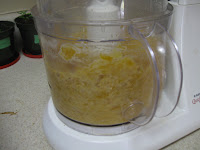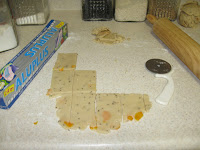Since we now live within driving distance of a U.S. post office, I felt an obligation to ship Christmas presents this year. But I also felt an immense anxiety about finding Christmas presents, since we live within driving distance of numerous U.S. shopping centers, which give me the heebie-jeebies. Of course, I would want to give something culturally unique, if possible, and that would mean going to a Mexican market, which is only one step better than a mall. So instead of a buying spree, I went on a baking spree, of Latin-influenced Christmas cookies.
My first variety was inspired by a sign I saw on a local bakery, which stated that it had "
buñuelos para Navidad." These fritters come in the shape of balls, twists, or pancakes with toppings and/or fillings that vary by country; in Mexico, they are generally thin pancakes sprinkled with cinnamon and sugar. The sweet was brought to the Americas from the Iberian Peninsula, where they were probably adapted from a Moorish (Arab) recipe. In fact, after the Spanish Inquisition, the dish spread to many parts of the world, and now Catholics serve them at Christmas; Jews, at Hanukkah; and Muslims, at Ramadan.
The mixing of the dough was quite easy, except for the requirement to sift the flour. Normally, I would just skip this step, but with something that is going to be fried, you don't want lumpy flour leaving
air pockets that will pop grease into your face, so I improvised with a wire colander. After sharking and forking the flour through the narrow openings, the dry ingredients were smooth enough to mix with the wet ones.


With the recent
empanada debacle still fresh in my mind, I was a little worried about rolling out the dough, which I had to knead for quite a while (I considered this my arm workout for the week). But actually, this dough was quite easy to thin out, especially since there was no need to be perfect in the size or shape.
While frying, the flattened dough would bubble up, which made me a little nervous, but none of them ever popped. It was quite simple to flip and remove them with a spatula, much easier than the samosas and empanadas. The hardest part, actually, was sprinkling on the cinnamon-sugar mixture while the fritters were still damp with oil; without the topping, these treats are actually quite bland.
Next up were
polvorones, which take their name from the Spanish word "polvo," which means “dust,” probably because of their crumbly consistency and/or the powdered sugar topping. This recipe, also likely with Arabic roots, was brought to Latin colonies from the Iberian Peninsula. The original cookies, called mantecados – from the Spanish word "manteca," or "lard" – are served at festivities year-round, but polvorones are usually reserved as a treat for Christmas.
When it came to mixing the dough for these cookies, I was uber-grateful for two hand-me-down appliances from my mother-in-law. First, an old coffee grinder made quick work of mashing walnuts into a paste. Second, a multi-function mixer spun the bowl automatically as I added flour, making the incorporation of a thick dough easy as pie (although in my opinion, pie is not really easy at all).
Once the dough got too thick, I did have to use my own power to mix in the remaining walnut pieces. But at least I didn't have to do any rolling with a pin this time. I was able to roll with my hands instead. After doing a little quality control with a measuring spoon, I got accustomed to shaping the appropriate size in my palms.
The funnest part of this recipe was dipping the baked and cooled cookies in the confectioners' sugar, which made me feel like the Swedish chef, with sweet, white dust a-flyin' everywhere. In terms of actual taste, these cookies were my favorite of the Latin selections, probably because I really packed on the powder.
In truth, I picked
bizcochitos because I liked saying the name. These shortbread cookies, named after a type of wood that burns even when wet, are an adaptation of mantecados and polvorones, influenced by the variety of Hispanic immigrants in the Southwest. In particular, anise and liquor were added to the dough. Although they are popular among Mexicans, they are so popular in New Mexico that they were adopted as the state cookie in 1989.
The mixing for this cookie included a couple of interesting steps. One was toasting the anise seeds, which really brought out their flavor and scent. The other was soaking the orange zest in alcohol; the recipe called for sherry, but I went with Madeira wine left over from our Thanksgiving dinner.
This dough was definitely simple to roll, especially after it had been chilled for a while. The cutting was almost as easy, especially with a pizza cutter and an aluminum foil box used as a guide for size. However, the peels of oranges, which were my version of zest since I only had a peeler, were a little stubborn, and the precise measurement was a bit time-consuming.
Another drawn-out step was pinching one of the sides "into deditos (little toes) which will spread apart when baking." My cookies' digits never stretched out in the oven, so the one end just looked like the crimping on a pie crust. Although I could learn to love the unusual flavor of these cookies, it was disconcerting to bite into those orange peels, so I bought a zester as a Christmas present to myself this year.


The last selection was a bit of a stretch, as
yo-yos are as representative of Latin culture as Oreos are of U.S. culture. Obviously, this sandwich cookie, a form of pan dulce, is named after the toy it resembles. Typically, the filling is raspberry jam, and the cookies are covered in coconut. It is not to be confused with the yo-yo in Venezuela, which is a sandwich of plantains and white cheese covered in beaten egg and fried.
Once again, the mixer was a blessing with this thick dough. It even let me mix in some holly sprinkles, which was my way of trying to compensate for these cookies not being actually very traditional. I hoped a little decorative finesse would turn them into "Mexican-American fusion cuisine."
After the polvorones, the rolling of the dough was almost second nature. I did keep forgetting to flatten the balls with a fork before I baked them. I didn't really understand this step anyhow because the first few batches spread out so quickly that the marks disappeared. I think that, in this high-volume recipe, I relied too much on the mixer to blend in the butter, so it was unevenly dispersed in the batter.
I'm not actually a fan of jelly, so I found the last step of combining the cookies into sandwiches with jam particularly annoying. After all, I'm the kind of person who "unscrews" Oreos to eat the parts separately. So I tried to make myself feel gourmet by using Paula Deen's jarred preserves as the filling. Perhaps because of the preserves, I actually liked these cookies more than I thought I would.
Not a day after I finished this quartet of treats, I was invited to a Christmas cookie exchange. But of course, I had made only enough cookies for people's presents. So for the exchange, I opted for a dessert TJ actually likes and I love. Perhaps I went a bit overboard by making five types of fudge:
peanut butter,
dark chocolate-cinnamon,
chocolate-butterscotch,
chocolate-pistachio, and plain chocolate. But then again, making fudge is so much easier than mixing, rolling, frying, and filling cookies.
The process of making fudge is generally the same, so I will illustrate only the most complex recipe, called
fantasy fudge. It is the most complex because it called for the use of a candy thermometer. The only required tool in the least complex recipe, the peanut butter, was a microwave. Still, there is some skill in making fudge; it goes quick, so you have to have all your ingredients ready. So I gathered them next to where I melted the butter into the condensed milk.
The physically-demanding part of fudge is the constant stirring, which I was supposed to do until the "candy thermometer reaches 234 degrees F." 234? Really? I stirred until it seemed like most of the sugar was melted, just to the point were I started to smell some burning. Then I immediately pulled the saucepan off the stove and added the chocolate and marshmallow creme, which made me hungry for a hot-fudge sundae.
The first part of "baking" fudge, getting it in the pan before it seizes up, is tricky. But, for me at least, the trickiest part is letting it cool for hours before you taste a piece. I managed to refrain until the next day. This fudge actually seemed a bit gritty, which probably means I only got the sugar mixture up to 233 degrees F. But the grit is obviously sugar, so who cares?
After all of this time spent working out in the kitchen, I think I lost a couple of pounds. Plus, we ended up buying actual presents for a lot of people, so I think I dropped even more weight from shopping-induced stress. So now, I have a little wiggle room, mainly in my waistline, to indulge in the spare leftovers.







.JPG)





.JPG)

.JPG)

.JPG)

.JPG)

.JPG)

.JPG)

.JPG)

.JPG)




























